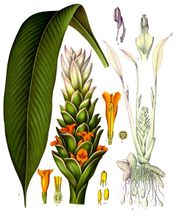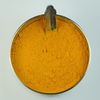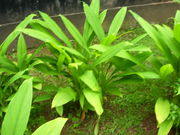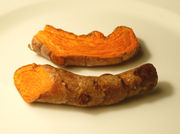Turmeric
| Turmeric | |
|---|---|
 |
|
| Curcuma longa | |
| Scientific classification | |
| Kingdom: | Plantae |
| Order: | Zingiberales |
| Family: | Zingiberaceae |
| Genus: | Curcuma |
| Species: | C. longa |
| Binomial name | |
| Curcuma longa Linnaeus[1] |
|
Turmeric (Curcuma longa) is a rhizomatous herbaceous perennial plant of the ginger family, Zingiberaceae.[2] It is native to tropical South Asia and needs temperatures between 20°C and 30°C, and a considerable amount of annual rainfall to thrive[3]. Plants are gathered annually for their rhizomes, and re-seeded from some of those rhizomes in the following season.
The rhizomes are boiled for several hours and then dried in hot ovens, after which they are ground into a deep orange-yellow powder commonly used as a spice in curries and other South Asian and Middle Eastern cuisine, for dyeing, and to impart color to mustard condiments. Its active ingredient is curcumin and it has a distinctly earthy, slightly bitter, slightly hot peppery flavor and a mustardy smell.
In medieval Europe, turmeric became known as Indian Saffron, since it was widely used as an alternative to the far more expensive saffron spice.[4]
Erode, a city in the south Indian state of Tamil Nadu, is the world's largest producer and most important trading center of turmeric in Asia. For these reasons, Erode in history is also known as "Yellow City" or "Turmeric City". Sangli, a town in the southern part of the Indian western state of Maharashtra, is the second largest and most important trading center for turmeric in Asia.
Contents |
Nomenclature and taxonomy
Kingdom | Plantae (plants), Phylum | Magnoliophyta (flowering plants), Class | Liliopsida (monoctyledons), Order | Zingiberales (gingers, bananas, birds-of-paradise, heliconias, costus, cannas, prayer plants, arrowroots, ...), Family | Zingiberaceae (ginger family), Genus | Curcuma (curcuma), Species | Curcuma longa (common turmeric),
Usage
Culinary uses

Turmeric grows wild in the forests of Southeast Asia. It has become the key ingredient for many Indian, Persian, Thai and Malay dishes, not only in curry, but also in masak lemak, rendang and many more.
In Indonesia, the turmeric leaves are used for Minangese or Padangese curry base of Sumatra such as rendang, sate padang and many other varieties.
Although most usage of turmeric is in the form of root powder, in some regions (especially in Maharashtra), leaves of turmeric are used to wrap and cook food. This usually takes place in areas where turmeric is grown locally, since the leaves used are freshly picked. This imparts a distinct flavor.
In non-South Asian recipes, turmeric is sometimes used as an agent to impart a rich, custard-like yellow color. It is used in canned beverages and baked products, dairy products, ice cream, yogurt, yellow cakes, orange juice, biscuits, popcorn color, sweets, cake icings, cereals, sauces, gelatins, etc. It is a significant ingredient in most commercial curry powders. Turmeric is mostly used in savory dishes, as well as some sweet dishes such as the cake Sfouf.
Although usually used in its dried, powdered form, turmeric is also used fresh, much like ginger. It has numerous uses in Far Eastern recipes, such as fresh turmeric pickle which contains large chunks of soft turmeric.
Turmeric (coded as E100 when used as a food additive)[5] is used to protect food products from sunlight. The oleoresin is used for oil-containing products. The curcumin/polysorbate solution or curcumin powder dissolved in alcohol is used for water-containing products. Over-coloring, such as in pickles, relishes, and mustard, is sometimes used to compensate for fading.
In combination with annatto (E160b), turmeric has been used to color cheeses, yogurt, dry mixes, salad dressings, winter butter and margarine. Turmeric is also used to give a yellow color to some prepared mustards, canned chicken broths and other foods (often as a much cheaper replacement for saffron).
Turmeric is widely used as a spice in South Asian and Middle Eastern cooking. Many Persian dishes use Turmeric, for the coloring of rice bottoms as well as as a starter ingredient for almost all Iranian fry ups (which typically consist of oil, onions and turmeric followed by any other ingredients that are to be included). In Nepal, turmeric is widely grown and is extensively used in almost every vegetable and meat dish in the country for its color as well as for its medicinal value. In South Africa turmeric is traditionally used to give boiled white rice a golden color.
Uses in folk medicine

In Ayurvedic practices, turmeric has many medicinal properties and many in South Asia use it as a readily available antiseptic for cuts, burns and bruises. It is also used as an antibacterial agent.
It is taken in some Asian countries as a dietary supplement, which allegedly helps with stomach problems and other ailments. It is popular as a tea in Okinawa, Japan. Pakistanis also use it as an anti-inflammatory agent, and remedy for gastrointestinal discomfort associated with irritable bowel syndrome, and other digestive disorders. In Afghanistan and northwest Pakistan, turmeric is applied to a piece of burnt cloth, and placed over a wound to cleanse and stimulate recovery. Indians, in addition to its Ayurvedic properties, use turmeric in a wide variety of skin creams that are also exported to neighboring countries.
Preliminary medical research
Turmeric is currently being investigated for possible benefits in Alzheimer's disease,[6] cancer, arthritis, and other clinical disorders.[7]

In the latter half of the 20th century, curcumin was identified as responsible for most of the biological effects of turmeric. According to a 2005 article in the Wall Street Journal, research activity into curcumin and turmeric is increasing, with supplement sales increased 35% from 2004. The U.S. National Institutes of Health currently has registered 19 clinical trials underway to study use of dietary turmeric and curcumin for a variety of clinical disorders (dated February 2010).[8]
Cosmetics
Turmeric is currently used in the formulation of some sunscreens. Turmeric paste is used by some Indian women to keep them free of superfluous hair. Turmeric paste is applied to bride and groom before marriage in some places of India, Bangladesh, and Pakistan, where it is believed turmeric gives glow to skin and keeps some harmful bacteria away from the body.
The government of Thailand is funding a project to extract and isolate tetrahydrocurcuminoids (THC) from turmeric. THCs are colorless compounds that might have antioxidant and skin-lightening properties and might be used to treat skin inflammations, making these compounds useful in cosmetics formulations.
Dye
Turmeric makes a poor fabric dye as it is not very lightfast (the degree to which a dye resists fading due to light exposure). However, turmeric is commonly used in Indian clothing, such as saris.
Gardening
Turmeric can also be used to deter ants. The exact reasons why turmeric repels ants is unknown, but anecdotal evidence suggests it works.[9]
Ceremonial uses
Turmeric is also used in various rituals, such as the turmeric ceremony or gaye holud, part of the Bengali wedding. It is widely used in all parts of India during wedding ceremony, particularly in North India and the Deccan Plateau.
It is also used in Pujas to make a form of the elephant God Ganesha. It is made by mixing turmeric with water and forming it into a cone-like shape.
During the south Indian festival Pongal, a whole turmeric plant with the root is placed as part of the ceremonial decorations. Also, fresh root is some times tied around the pot boiling the ceremonial rice.
In southern India, as a part of the marriage ritual, a piece of dried turmeric tied with string is sometimes used to replace the Thali necklace temporarily or permanently.
Modern Neopagans list it with the quality of fire, and it is used for power and purification rites.
In Goa and Dakshina Kannada (Karnataka state, India) turmeric plant leaf is used to prepare special sweet dishes, patoleo, by layering on the leaf — rice flour, and coconut-jaggery mixture, and then closing and steaming in a special copper steamer (goa).
Friedrich Ratzel in "The History of Mankind" reported in 1896 that in Micronesia the preparation of turmeric powder for embellishment of body, clothing and utensils had a highly ceremonial character.[10] He quotes an example of the roots being ground by four to six women in special public buildings and then allowed to stand in water. The following morning three young coconuts and three old soma nuts are offered by a priestess with prayer, after which the dye which has settled down in the water is collected, baked into cakes in coconut moulds, wrapped in banana leaves, and hung up in the huts till required for use.
Composition


Turmeric contains up to 5% essential oils and up to 5% curcumin, a polyphenol. It is the active substance of turmeric and it is also known as C.I. 75300, or Natural Yellow 3. The systematic chemical name is (1E,6E)-1,7-bis(4-hydroxy-3-methoxyphenyl)-1,6-heptadiene-3,5-dione.
It can exist at least in two tautomeric forms, keto and enol. The keto form is preferred in solid phase and the enol form in solution.
Curcumin is a pH indicator. In acidic solutions (pH <7.4) it turns yellow whereas in basic (pH > 8.6) solutions it turns bright red.
See also
- Alpinia zerumbet
- Etlingera elatior
- Kaempferia galanga
References
- ↑ "Curcuma longa information from NPGS/GRIN". www.ars-grin.gov. http://www.ars-grin.gov/cgi-bin/npgs/html/taxon.pl?12676. Retrieved 2008-03-04.
- ↑ Chan, E.W.C. et al. (2009). "Effects of different drying methods on the antioxidant properties of leaves and tea of ginger species". Food Chemistry 113 (1): 166–172. doi:10.1016/j.foodchem.2008.07.090. | accessyear = 2009}}
- ↑ Materia Indica, 1826, Whitelaw Ainslie, M.D. M.R.A.S., via Google Books
- ↑ Is it Turmeric or Saffron?
- ↑ UK food guide
- ↑ "Curry 'may slow Alzheimer's'". BBC News. 21 November 2001. http://news.bbc.co.uk/1/hi/health/1668932.stm. Retrieved 28 March 2010.
- ↑ http://www.mirror.co.uk/news/top-stories/2009/10/28/curry-kills-cancer-cells-and-other-health-benefits-of-the-nations-favourite-dish-115875-21779950/
- ↑ NIH-listed human clinical trials on turmeric and curcumin, February, 2010
- ↑ Ants Control Online Information Service for Non-Chemical Pest Control in the Tropics. Retrieved on 5 Feb 2010
- ↑ Ratzel, Friedrich. The History of Mankind. (London: MacMillan, 1896). URL: www.inquirewithin.biz/history/american_pacific/oceania/oceania-utensils.htm accessed 28 November 2009.
External links
- Turmeric, from the U.S. National Institutes of Health
- Turmeric List of Chemicals (Dr. Duke's)
- Plant Cultures: review of botany, history and uses
- Scientists say curry compound kills cancer cells
|
||||||||||||||||||||||||||||||||||||||||||
_W_IMG_2440.jpg)